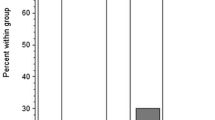Abstract
Fabry's disease, X-linked α-galactosidase deficiency, features a variety of autonomic abnormalities including anhidrosis. In this study, we measured the skin sympathetic nerve activity (SSNA), skin potential and sweat rate in a symptomatic female carrier to investigate the underlying pathophysiology of anhidrosis. The basal activity and responsiveness of SSNA were both fairly well preserved, although slightly reduced compared with the control levels. However, sweating was completely absent, despite the normal skin potential change in response to SSNA bursts. These results suggest that anhidrosis in Fabry's disease is a result of sweat gland dysfunction as well as abnormal SSNA.
Similar content being viewed by others
References
Desnick RJ, Llionsky B, Sweeley CC. Fabry's disease (α-galactosidase A deficiency). In: Stanbury JB, Fredrickson DS, eds.Metabolic Basis of Inherited Disease. New York: McGraw-Hill, 1978; 810–840.
Kint JA. Fabry's disease: alpha-galactosidase deficiency.Science 1970;167: 1268–1269.
Cable WJL, Kolodny EH, Adams RD. Fabry's disease.J Clin Invest 1989;83: 1390–1399.
Bernstein HS, Bishop DF, Astrin KH. Fabry's disease: six gene rearrangements and an exonic point mutation in the alpha-galactosidase gene.Nucleic Acids Res 1989;17: 3301–3302.
Hagbarth KE, Hallin RG, Hongell A, Torebjörk HE, Wallin BG. General characteristics of sympathetic activity in human skin nerve.Acta Physiol Scand 1972;84: 164–176.
Wallin BG. Intraneural recordings of normal and abnormal sympathetic activity in man. In: Bannister R, Mathias CJ, eds.Autonomic Failure. A Textbook of Clinical Disorders of the Autonomic Nervous System, 3rd edn. London: Oxford University Press, 1992; 359–377.
Mano T. Sympathetic nerve mechanisms of human adaptation to environment — findings obtained by recent microneurographic studies.Environ Med 1990;34: 1–35.
Bini G, Kagbarth KE, Hynninen P, Wallin BG. Thermoregulatory and rhythm-generating mechanisms governing the sudomotor and vasoconstrictor outflow in human cutaneous nerves.J Physiol (Lond) 1980;306: 537–552.
Shahani BT, Harperin JJ, Boulu P. Sympathetic skin response — a method of assessing unmyelinated axon dysfunction in peripheral neuropathies.J Neurol Neurosurg Psychiat 1984;47: 536.
Murakami K, Sobue G, Iwase S, Mano T, Mitsuma T. Skin sympathetic nerve activity in acquired idiopathic generalized anhidrosis.Neurology 1993;43: 1137–1139.
Iwase S, Ikeda T, Hakusui Set al. Hyperresponsiveness in skin sympathetic nerve activity to mental and thermal stimuli in primary palmoplantar hyperhidrosis.Environ Med 1994;38: 175–178.
Sugenoya J, Iwase S, Mano T, Ogawa T. Identification of sudomotor activity in cutaneous sympathetic nerve using sweat expulsion as effector response.Eur J Appl Physiol 1990;61: 302–308.
Sugenoya J, Ogawa T. Characteristics of central sudomotor mechanism estimated by frequency of sweat expulsion.Jpn J Physiol 1985;35: 783–794.
Yamamoto K, Sobue G, Iwase S, Mitsuma T, Mano T. Skin sympathetic nerve activity in amyotrophic lateral sclerosis.Clin Neurol 1994;34: 377–380.
Okamoto T, Iwase S, Sugenoya J, Mano T, Sugiyama Y, Yamamoto K. Different thermal dependency of cutaneous sympathetic outflow to glabrous and hairy skin in human.Eur J Appl Physiol 1994;68: 460–464.
Author information
Authors and Affiliations
Rights and permissions
About this article
Cite this article
Yamamoto, K., Sobue, G., Iwase, S. et al. Possible mechanism of anhidrosis in a symptomatic female carrier of Fabry's disease: an assessment by skin sympathetic nerve activity and sympathetic skin response. Clinical Autonomic Research 6, 107–110 (1996). https://doi.org/10.1007/BF02291231
Received:
Accepted:
Issue Date:
DOI: https://doi.org/10.1007/BF02291231




